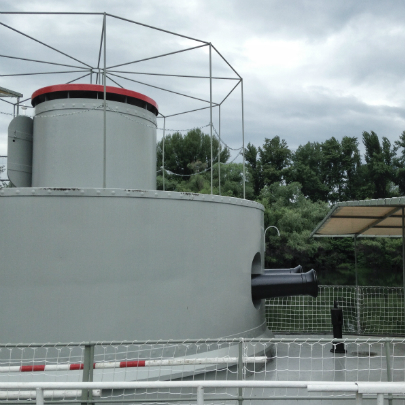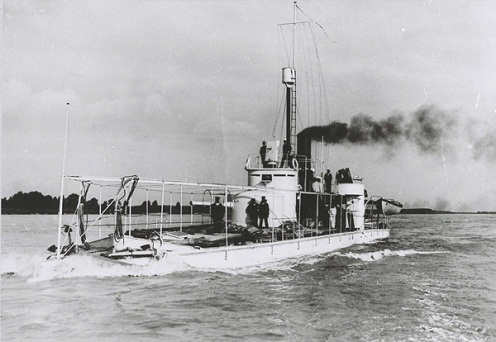The LAJTA Monitor
MUSEUM BOAT
Hungary’s oldest warship is now on display on the Danube.

The Museum and Institute of Military History in Budapest is organizing several projects to commemorate the anniversary of the outbreak of the I. World War. Besides a permanent exhibition on the First World War and operating a museum train, the oldest Hungarian military warship, LAJTA, is anchored near the parliament, and now open for visitors.
This boat is grossly different from the rest on the river Danube. The unique design includes a hull which is unusually low, a curvy deck, and a large conning tower clearly indicating that this is an extra-ordinary vessel. The word monitor refers to the class of this warship. It has a conning tower with two guns and is driven by a steam engine.
It was launched on 17 May 1871 in the north of Budapest. For 46 years it served under the name of LEITHA in the River Fleet of the Austro-Hungarian Empire. It was deployed during occupying Bosnia and it also fought during the IWW on the river Sava, near Belgrade and on the lower sections of the Danube. The vessel was finally decommissioned in April 1918.
The LEITHA and its sibling the MAROS were the first river monitors in Europe and the first in the world on which a Coles weapon mount was built. Among many other firsts, they were also the first ships in the fleet of the Austro-Hungarian Empire which did not have sails, they were exclusively driven by a steam engine. They were the first to be built exclusively of metal and with a turret which was able to turn around. Additionally, no ship before these had ever sported a flush toilet.
 In May and June 1919 it was redeployed, this time under the name LAJTA and it took part in the fights on the Danube north-west of Budapest. Finally it was used in the military crack down on the Hungarian Soviet Republic even giving its name to this military intervention which is now known as the “monitor rebellion”. In 1921, following the Trianon Treaty rulings, it was dismantled and the hull was auctioned. From 1928 for 65 years it served as a floating platform for river works and maintenance. Amateur ship fans were making a lot of efforts to save this vessel and have it placed under protection. This finally happened in 1992 and renovation could start then.
In May and June 1919 it was redeployed, this time under the name LAJTA and it took part in the fights on the Danube north-west of Budapest. Finally it was used in the military crack down on the Hungarian Soviet Republic even giving its name to this military intervention which is now known as the “monitor rebellion”. In 1921, following the Trianon Treaty rulings, it was dismantled and the hull was auctioned. From 1928 for 65 years it served as a floating platform for river works and maintenance. Amateur ship fans were making a lot of efforts to save this vessel and have it placed under protection. This finally happened in 1992 and renovation could start then.
In 2014 the LAJTA was towed to the parliament in Budapest and now it is a permanent exhibition site as part of the new visitor centre of the parliament building. 15-20 visitors may be on board at a time walking along the deck into the captain’s cabin, through the sailors’ room and the kitchen down to the engine room and the boiler.
 The boat, which is maintained by the Zoltan Foundation will also be taking part in a centenary Danube tour between Vienna and Mohács, the last town on the Hungarian side before the Serbian border. It will be calling at ports along the river where, as part of the IWW commemoration ceremonies, people can embark and enjoy this magnificent vessel.
The boat, which is maintained by the Zoltan Foundation will also be taking part in a centenary Danube tour between Vienna and Mohács, the last town on the Hungarian side before the Serbian border. It will be calling at ports along the river where, as part of the IWW commemoration ceremonies, people can embark and enjoy this magnificent vessel.
The ship offers guided tours and a small gift shop serves those with passion for boats and the military.